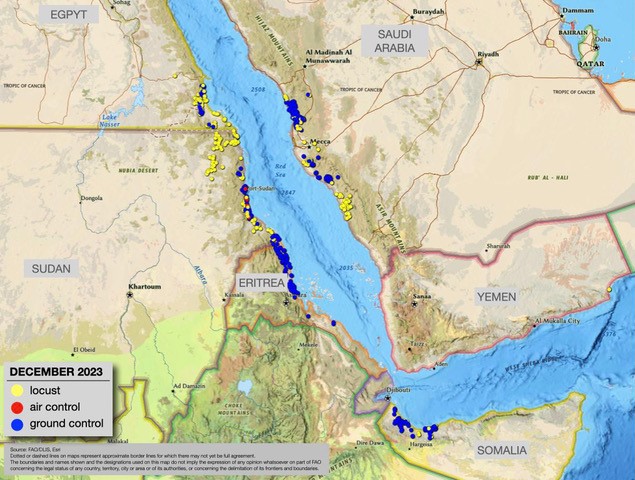5 January 2024. Central region outbreaks continue
KEY POINTS
• Current situation: Outbreaks persist with breeding, groups and bands in Egypt, Eritrea, Saudi Arabia, Somalia, Sudan; a few locusts in Mauritania, Western Sahara, Morocco, Algeria, Niger.
• Control: Increased fivefold in Egypt, Eritrea, Saudi Arabia, Somalia (only biopesticides), Sudan (some air); a few in Mauritania.
• January–March: second generation with breeding, hatching, groups and bands along parts of the Red Sea and the Gulf of Aden coasts.
________________________
Central Region outbreaks in December.
The four Desert Locust outbreaks that began in November persisted in December along the coasts of the Red Sea and Gulf of Aden in the Central Region.
Copulating, laying, and hatching led to an increase in hopper groups and small bands during the first winter generation breeding in Sudan, Eritrea, Saudi Arabia, northwest Somalia, and southeast Egypt. Control operations in the five countries increased fivefold compared to November, with additional air control in Sudan and the exclusive use of biopesticides in Somalia.
The forecast predicts that the first winter generation will end in January. The weather models predict below-normal rainfall along the Red Sea and Gulf of Aden coasts in the next few months. However, a second generation is likely to occur in January and February, specifically in Sudan, Eritrea, and Yemen, where rain is expected to be normal or above normal. Control operations should continue.
Elsewhere, a few locusts occurred in parts of northwest Mauritania, Western Sahara, Morocco, Algeria, and Niger. No significant developments are likely in the Western and Eastern Regions.
See LocustWatch: www.fao.org/ag/locusts





